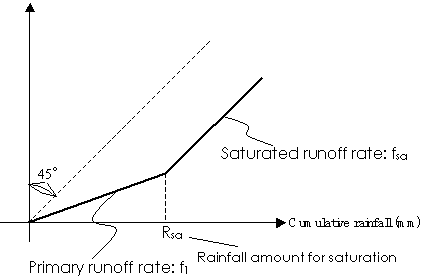The f1-Rsa Model is used to calculate the effective rainfall when using the Quasi Linear Reservoir Method; a standard runoff model used in Japan.
See the Japanese Runoff Methodology technical paper for further information.
In the f1-Rsa method, an initial runoff rate, f1, is applied until the cumulative rainfall reaches a specified saturated rainfall value. A second runoff rate, fsa, is then applied.

Using the f1-Rsa model
To use the f1-Rsa model in InfoWorks ICM, set the Runoff Volume Type field of the Runoff Surface to f1-Rsa.
Parameters are entered as follows:
- f1 - Minimum runoff field
- fsa - Maximum runoff field
- Rsa - Saturated rainfall field
Initial cumulative rainfall is set in the antecedent rainfall depth of the rainfall event, set in the sub-event properties.
Standard values of f1 and Rsa are shown below. These values can be used for a first approximation:
| Parameter | Rural area | Urbanised area |
|---|---|---|
| f1 | 1 | 0.5 |
| Rsa (mm) | 100 | 50 |
Standard values of f1, Rsa and fsa for typical land use patterns:
| Rice field | Farmland | Mountain |
Residential area 2 degree* |
Residential area 4 degree** |
|
|---|---|---|---|---|---|
| f1 | 0.0 | 0.15 | 0.25 | 0.7 | 0.9 |
| Rsa (mm) | 50.0 | 300.0 | 150.0 | 55.0 | 55.0 |
| fsa | 1.0 | 0.6 | 1.0 | 1.0 | 1.0 |
*2 degree - roads are installed quite well, drainage systems are not fully installed
**4 degree - all of the planned areas to be paved are paved, drainage systems are fully installed
